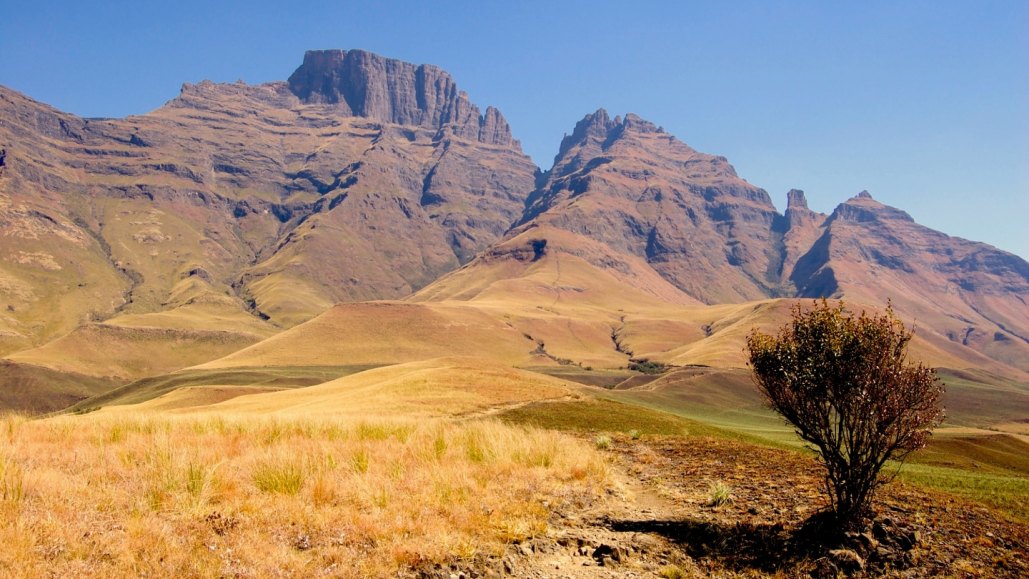"Mantle Waves Elevate Continents and Adorn Them with Diamonds"

For billions of years, the continents have cruised across Earth’s surface like tectonic vessels, but they have not survived unscathed. Waves in the underlying layer known as the mantle can scour off the keels of continents, buoying their surfaces upward to form prominent landforms far from any active plate boundaries, researchers propose in the Aug. 8 Nature. The study provides a plausible origin story for enigmatic plateaus that protrude from otherwise geologically sedate landscapes.
The researchers have “been able to extend out and link together processes that we’ve speculated about for a long period of time,” says geologist David Foster of the University of Florida in Gainesville. The study builds on research published last year, which suggested that mantle waves also triggered eruptions of diamond-bearing magmas called kimberlites.
At the center of this story lie the cratons, large blocks of mostly crystalline rock that typically occupy the interiors of continents. They are the oldest fragments of Earth’s crust, with many having formed more than 2.5 billion years ago, during the Archean Eon. Much of the crust that once existed on Earth has been destroyed in subduction zones, where one tectonic plate plunges beneath another into the mantle. The cratons, however, evaded that fate.
Cratons owe their longevity to their roots, or keels, Foster says. Cratons are much thicker than surrounding continental crust, with keels that can extend hundreds of kilometers down into the mantle. The keels are relatively buoyant, thereby helping to keep cratons afloat and intact while other parts of the crust get subducted.
But something about the cratons had long puzzled geologists. Some, such as the Kaapvaal craton in southern Africa, are topped by vast plateaus that are rimmed by dramatic escarpments. But cratons are supposedly stable and often located far from the land-lifting tectonic activity that occurs at plate boundaries. So what raised these plateaus?
Some studies have proposed that the landforms arose as the craton passed over a large plume of material upwelling from deep in the mantle. But the geologic record doesn’t appear to support that explanation, says earth scientist Thomas Gernon of the University of Southampton in England.
So Gernon and colleagues harnessed computer simulations to track the evolution of a rift that opened in the middle of a continent. They found that pressure changes beneath the rift stirred up circulations in the mantle, inciting a wave that propagated laterally under a continent roughly 20 kilometers every million years.
When the wave met a craton’s keel in the simulation, it excoriated and swept material away into the mantle. This progressively unburdened the continent, causing the overlying surface to rise upward like a ship relieved of cargo. This uplift followed the mantle waves for hundreds of kilometers across the craton, raising a stable plateau roughly one to two kilometers high, Gernon says. And as these raised regions were eroded by wind and water, the surface buoyed up even more.
Continental rifts can kick off waves in the underlying mantle that bumps up the crust and builds an extended plateau. Click through the slideshow below to see how this happens. In each illustration, the continent is divided into its upper crust, lower crust and continental lithosphere layers plus a relatively unstable thermal boundary layer. Beneath the continent is the asthenosphere, the ductile upper layer of Earth’s mantle.
How mantle waves buoy Earth’s surface to form broad plateaus
The researchers also linked their simulations to the geologic record. From previously published research, they pulled geochemical data from rocks in the Southern Africa plateau, which recorded the plateau’s thermal history. The data showed that the fastest rates of cooling — a proxy for when the rocks were being uplifted most rapidly — swept across the plateau at a pace that aligned with the migration of a mantle wave.
The study links together many disparate hypotheses, says geophysicist Cynthia Ebinger of Tulane University in New Orleans. Scientists had previously linked rifting to kimberlite volcanism and shown that craton keels could be excoriated by material circulating in the mantle. But until now, no one had connected those pieces with the cratons’ enigmatic topography.
“These Archean fragments are still controlling aspects of plate tectonics,” Ebinger says. “That early stage in Earth’s history is still really important.”




